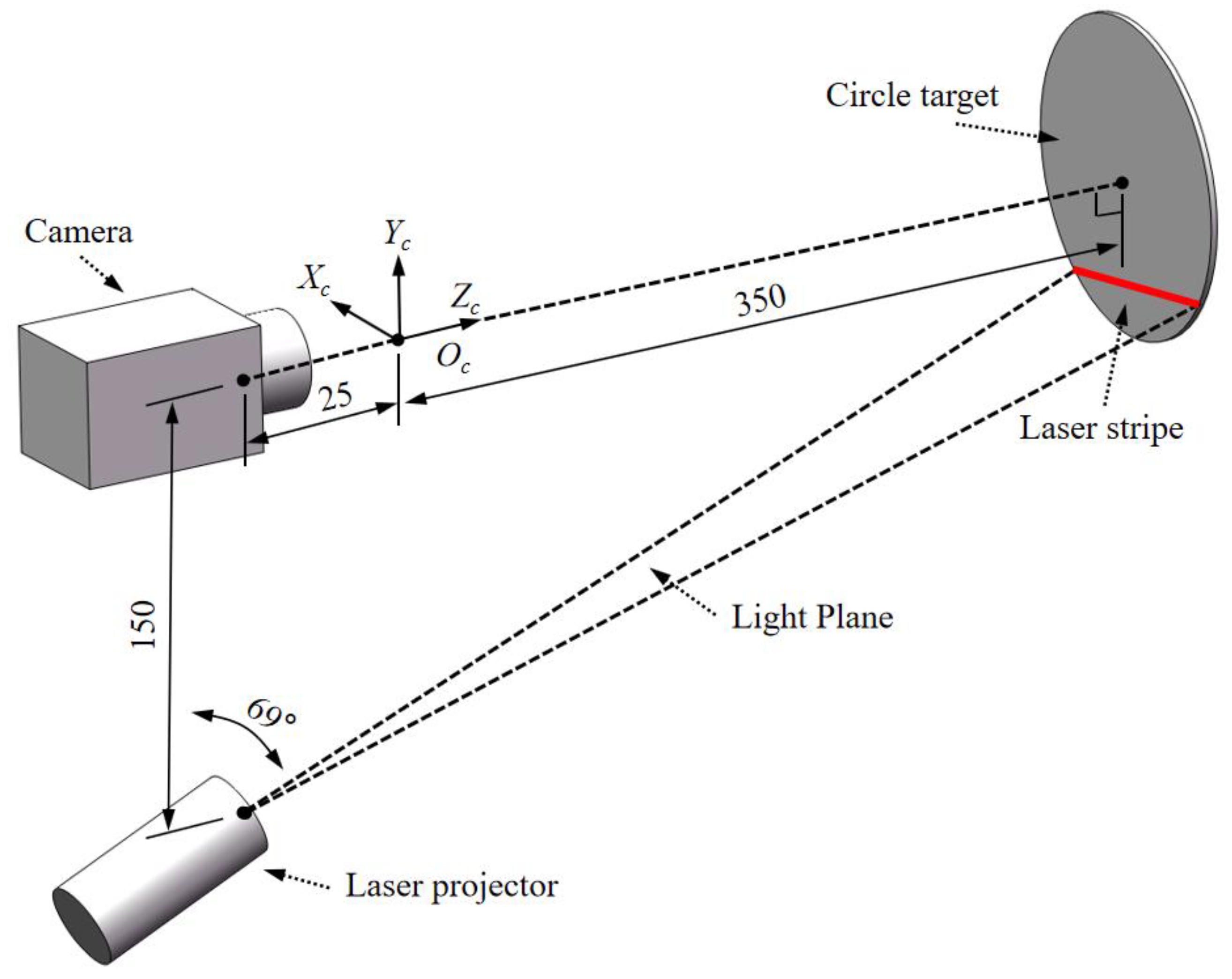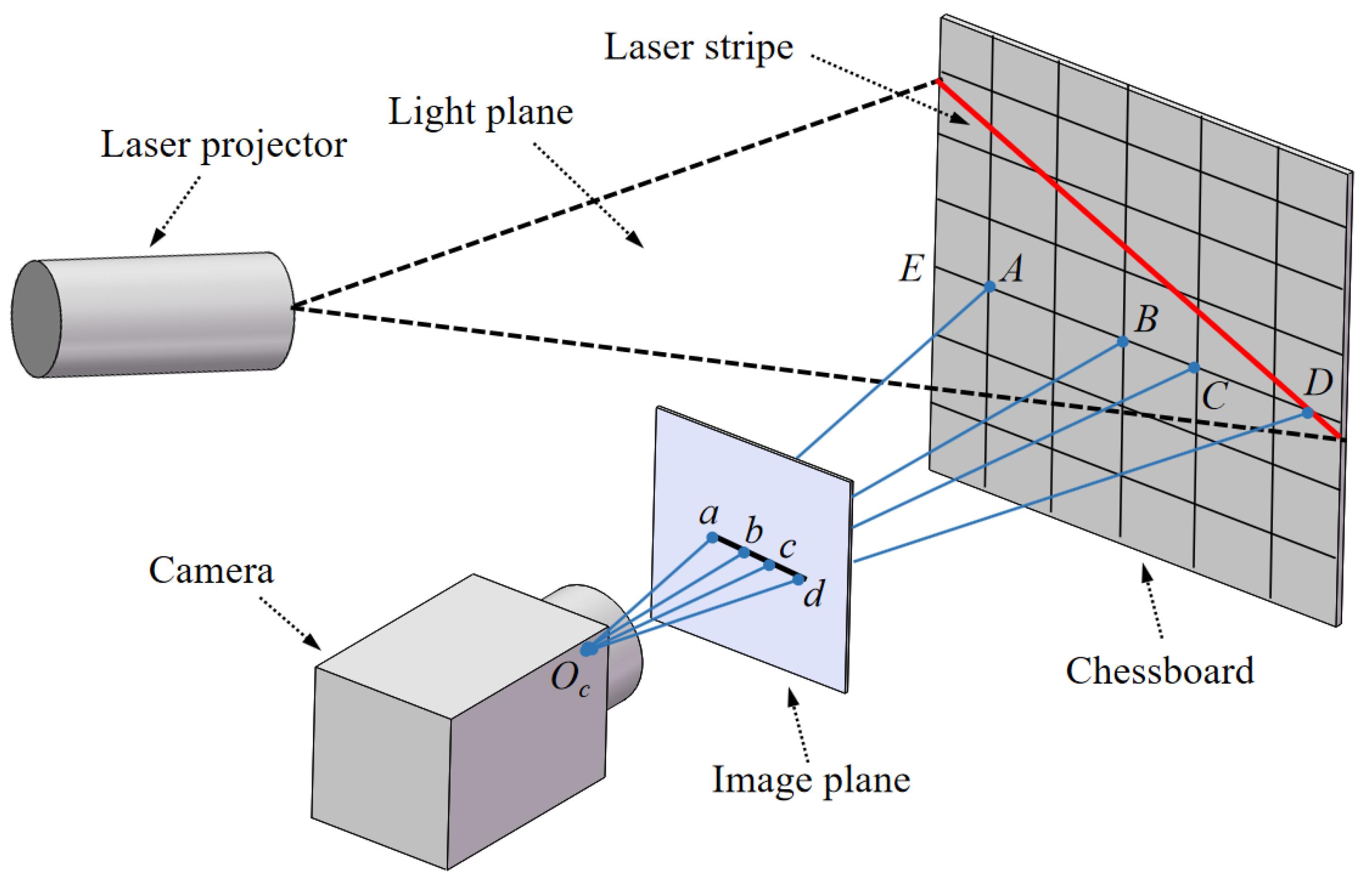Calibration Method for Line-Structured Light Three-Dimensional Measurements Based on a Single Circular Target
Abstract
:1. Introduction
2. Principles
2.1. Line-Structured Light 3D Measurement Model
2.2. Light Plane Calibration Based on a Single Circle Target
2.2.1. Image Processing Algorithm
2.2.2. Single Circle Position and Posture Measurement
- 1.
- Solving the elliptic cone equation of Q in the CCS
- 2.
- Converting Q from the CCS to SCS
- 3.
- Determining the parameters of two possible circles
2.2.3. Progressive Solution of the Light Plane Equation
- 1.
- Initial light plane determination
- 2.
- Progressive refining of the light plane
3. Simulations
3.1. Influence of the Number of Target Placements
3.2. Influence of Image Noise
3.3. Influence of Circular Target Size
4. Experiments
4.1. Experimental Setup
4.2. Experimental Procedure
4.3. Accuracy Evaluation
5. Conclusions
Author Contributions
Funding
Data Availability Statement
Conflicts of Interest
References
- Andrew, M.; Luca, M.; David, T.I.; Wilson, M. The quality of measurement results in terms of the structural features of the measurement process. Measurement 2018, 116, 611–620. [Google Scholar]
- Jason, R.; Alain, P.; Michael, S.; Artemenko, O.; Stricker, D. 6DoF Object Tracking based on 3D Scans for Augmented Reality Remote Live Support. Computers 2018, 7, 7010006. [Google Scholar]
- Piotr, S.; Kraysztof, M.; Jan, R. On-Line Laser Triangulation Scanner for Wood Logs Surface Geometry Measurement. Sensors 2019, 19, 1074. [Google Scholar]
- Tang, Y.; Li, L.; Wang, C.; Chen, M.; Feng, W.; Zou, X.; Huang, K. Real-time detection of surface deformation and strain in recycled aggregate concrete-filled steel tubular columns via four-ocular vision. Robot. Comput.-Integr. Manuf. 2019, 59, 36–46. [Google Scholar] [CrossRef]
- Tang, Y.; Chen, M.; Wang, C.; Luo, L.; Li, J.; Lian, G.; Zou, X. Recognition and Localization Methods for Vision-Based Fruit Picking Robots: A Review. Front. Plant Sci. 2020, 11, 510. [Google Scholar] [CrossRef]
- Wang, Z. Review of Real-time Three-dimensional Shape Measurement Techniques. Measurement 2020, 156, 107624. [Google Scholar] [CrossRef]
- Xu, X.B.; Fei, Z.W.; Yang, J.; Tan, Z.; Luo, M. Line structured light calibration method and centerline extraction: A review. Results Phys. 2020, 19, 103637. [Google Scholar] [CrossRef]
- Zhang, Z.Y. A Flexible New Technique for Camera Calibration. IEEE Trans. Pattern Anal. Mach. Intell. 2000, 22, 1330–1334. [Google Scholar] [CrossRef] [Green Version]
- Huang, L.; Da, F.; Gai, S. Research on multi-camera calibration and point cloud correction method based on three-dimensional calibration object. Opt. Lasers Eng. 2019, 115, 32–41. [Google Scholar] [CrossRef]
- Wang, Y.; Yuan, F.; Jiang, H.; Hu, Y. Novel camera calibration based on cooperative target in attitude measurement. Opt. -Int. J. Light Electron Opt. 2016, 127, 10457–10466. [Google Scholar] [CrossRef]
- Huynh, D.Q.; Owens, R.A.; Hartmann, P.E. Calibration a Structured Light Stripe System: A Novel Approach. Int. J. Comput. Vis. 1999, 33, 73–86. [Google Scholar] [CrossRef]
- Xu, G.Y.; Li, L.F.; Zeng, J.C. A new method of calibration in 3D vision system based on structure-light. Chin. J. Comput. 1995, 18, 450–456. [Google Scholar]
- Dewar, R. Self-generated targets for spatial calibration of structured light optical sectioning sensors with respect to an external coordinate system. Robot. Vis. Conf. Proc. 1988, 1, 5–13. [Google Scholar]
- Zhou, F.; Zhang, G. Complete calibration of a structured light stripe vision sensor through planar target of unknown orientations. Image Vis. Comput. 2005, 23, 59–67. [Google Scholar] [CrossRef]
- Zhang, G.; Zhen, L.; Sun, J.; Wei, Z. Novel calibration method for multi-sensor visual measurement system based on structured light. Opt. Eng. 2010, 49, 258. [Google Scholar] [CrossRef]
- Jing, X.; Douet, J.; Zhao, J.; Song, L.; Chen, K. A simple calibration method for structured light-based 3D profile measurement. Opt. Laser Technol. 2013, 48, 187–193. [Google Scholar]
- Wei, Z.; Cao, L.; Zhang, G. A novel 1D target-based calibration method with unknown orientation for structured light vision sensor. Opt. Laser Technol. 2010, 42, 570–574. [Google Scholar] [CrossRef]
- Liu, Z.; Li, X.; Li, F.; Zhang, G. Calibration method for line-structured light vision sensor based on a single ball target. Opt. Lasers Eng. 2015, 69, 20–28. [Google Scholar] [CrossRef]
- Li, X.; Zhang, Z.; Yang, C. Reconstruction method for fringe projection profilometry based on light beams. Appl. Opt. 2016, 55, 9895. [Google Scholar] [CrossRef]
- Bouguet, J.Y. Camera Calibration Toolbox Got MATLAB. 2015. Available online: http://www.vision.caltech.edu/bouguetj/calib_doc/ (accessed on 20 October 2021).
- Maratea, A.; Petrosino, A.; Manzo, M. Extended Graph Backbone for Motif Analysis. In Proceedings of the 18th International Conference on Computer Systems and Technologies, Ruse, Bulgaria, 23–24 June 2017; pp. 36–43. [Google Scholar]
- Tsuji, S.; Matsumoto, F. Detection of ellipses by a modified Hough transformation. IEEE Trans. Comput. 2006, 27, 777–781. [Google Scholar] [CrossRef]
- Chia, A.Y.S.; Rahardja, S.; Rajan, D.; Leung, M.K. A split and merge based ellipse detector with self-correcting capability. IEEE Trans. Image Process. 2011, 20, 1991–2006. [Google Scholar] [CrossRef] [PubMed]
- Gioi, R.; Jakubowicz, J.; Morel, J.M.; Randall, G. LSD: A Fast Line Segment Detector with a False Detection Control. IEEE Trans. Pattern Anal. Mach. Intell. 2010, 32, 722–732. [Google Scholar] [CrossRef] [PubMed]
- Paul, L.R. A note on the least squares fitting of ellipses. Pattern Recognit. Lett. 1993, 14, 799–808. [Google Scholar]
- Kulpa, K. On the properties of discrete circles, rings, and disks. Comput. Graph. Image Process. 1979, 10, 348–365. [Google Scholar] [CrossRef]
- Ellenberger, S.L. Influence of defocus on measurements in microscope images. Appl. Sci. 2000, 15, 43–50. [Google Scholar]
- Zhang, L.J.; Huang, X.X.; Feng, W.C.; Liang, S.; Hu, T. Solution of duality in circular feature with three line configuration. Act Opt. Sin. 2016, 36, 51. [Google Scholar]











| No. | Pixel Coordinates (Unit: Pixels) | Cross-Ratio Invariability in the Target Coordinate System (Unit: mm) | 3D Coordinates of Testing Points Computed by Zhou’s Method (Unit: mm) | 3D Coordinates of Testing Points Computed by Our Proposed Method (Unit: mm) | |||||||
|---|---|---|---|---|---|---|---|---|---|---|---|
| 1 | 424.0 | 631.5 | 45.715 | 20 | 0 | 3.262 | 12.453 | 447.108 | 3.271 | 12.486 | 448.308 |
| 2 | 519.6 | 641.6 | 44.284 | 30 | 0 | 13.011 | 13.432 | 445.060 | 13.048 | 13.470 | 446.297 |
| 3 | 616.5 | 653.5 | 43.920 | 40 | 0 | 22.790 | 14.577 | 442.758 | 22.856 | 14.619 | 444.029 |
| 4 | 713.5 | 665.0 | 43.133 | 50 | 0 | 32.483 | 15.672 | 440.537 | 32.579 | 15.719 | 441.842 |
| 5 | 910.0 | 690.0 | 41.093 | 70 | 0 | 51.794 | 18.018 | 435.861 | 51.957 | 18.075 | 437.232 |
| 6 | 238.0 | 607.0 | 44.514 | 0 | 0 | −15.993 | 10.034 | 451.893 | −16.033 | 10.059 | 453.023 |
| 7 | 334.0 | 607.0 | 45.290 | 10 | 0 | −6.030 | 10.022 | 451.347 | −6.046 | 10.048 | 452.525 |
| 8 | 430.5 | 607.0 | 42.974 | 20 | 0 | 3.961 | 10.010 | 450.800 | 3.972 | 10.037 | 452.025 |
| 9 | 526.8 | 607.0 | 45.806 | 30 | 0 | 13.907 | 9.998 | 450.255 | 13.947 | 10.026 | 451.527 |
| 10 | 720.5 | 607.0 | 45.211 | 50 | 0 | 33.841 | 9.973 | 449.164 | 33.944 | 10.004 | 450.529 |
| No. | dt | dm1 | dm2 | Δ(dt, dm1) | Δ(dt, dm2) |
|---|---|---|---|---|---|
| 1 | 10.102 | 10.010 | 10.030 | 0.091 | 0.072 |
| 2 | 20.081 | 20.120 | 20.160 | −0.039 | −0.080 |
| 3 | 30.111 | 30.124 | 30.187 | −0.013 | −0.076 |
| 4 | 50.213 | 50.128 | 50.242 | 0.085 | −0.029 |
| 5 | 10.030 | 9.978 | 10.000 | 0.052 | 0.030 |
| 6 | 20.059 | 19.984 | 20.030 | 0.075 | 0.029 |
| 7 | 30.028 | 29.945 | 30.017 | 0.082 | 0.011 |
| 8 | 50.005 | 49.909 | 50.039 | 0.096 | −0.034 |
| RMS error | 0.072 | 0.051 | |||
Publisher’s Note: MDPI stays neutral with regard to jurisdictional claims in published maps and institutional affiliations. |
© 2022 by the authors. Licensee MDPI, Basel, Switzerland. This article is an open access article distributed under the terms and conditions of the Creative Commons Attribution (CC BY) license (https://creativecommons.org/licenses/by/4.0/).
Share and Cite
Wang, J.; Li, X. Calibration Method for Line-Structured Light Three-Dimensional Measurements Based on a Single Circular Target. Appl. Sci. 2022, 12, 588. https://doi.org/10.3390/app12020588
Wang J, Li X. Calibration Method for Line-Structured Light Three-Dimensional Measurements Based on a Single Circular Target. Applied Sciences. 2022; 12(2):588. https://doi.org/10.3390/app12020588
Chicago/Turabian StyleWang, Jun, and Xuexing Li. 2022. "Calibration Method for Line-Structured Light Three-Dimensional Measurements Based on a Single Circular Target" Applied Sciences 12, no. 2: 588. https://doi.org/10.3390/app12020588





